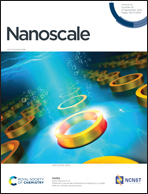Enhancing the electrical performance of InAs nanowire field-effect transistors by improving the surface and interface properties by coating with thermally oxidized Y2O3†
Abstract
Due to their excellent electrical characteristics, InAs nanowires (NWs) have great potential as conducting channels in integrated circuits. However, the surface effect and loose native oxide coverage can deteriorate the performance of InAs NW transistors. Y2O3, a high-k dielectric with low Gibbs free energy, has been proposed to modify the InAs NW surface. Here, we systematically investigate the effect of Y2O3 coating on the performance of InAs NW field-effect transistors (FETs). We first explore the influence of the thermal oxidation process of Y2O3 on the performance of back-gated FETs. We then observe that the coverage of Y2O3/HfO2 bilayers on the NW decreases the hysteresis (the smallest value reaches 0.1 V), subthreshold swing (SS, down to 169 mV dec−1) and on-state resistance Ron, and increases the field-effect mobility μFE (up to 4876.1 cm2 V−1 s−1) and the on–off ratio, mainly owing to the passivation effect on the NW surface. Finally, paired top-gated NW FETs with a Y2O3/HfO2 bilayer and a single layer of HfO2 dielectric are fabricated and compared. The Y2O3/HfO2 bilayer provides better gate control (SSmin = 113 mV dec−1) under a smaller gate oxide capacitance, with an interface trap density as low as 1.93 × 1012 eV−1 cm−2. The use of the Y2O3/HfO2 stack provides an effective strategy to enhance the performance of III–V-based transistors for future applications.



 Please wait while we load your content...
Please wait while we load your content...